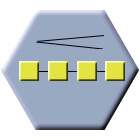Cognitive operator: Ordering: Difference between revisions
No edit summary |
|||
| Line 53: | Line 53: | ||
===Meta Workflow=== | ===Meta Workflow=== | ||
Help to discover the concept of "comparable" and what makes things easier to compare when a valuation attribute can be found. | |||
==Implementation== | ==Implementation== | ||
Revision as of 20:48, 12 February 2014
Operator
Complexity level
Ordering operator is of complexity 1, as there is only one arrangement action on a linear problem dimension.
Operations
Operation 1 : Define order of the input set from "LESS" to a "MOST" value of some criteria defined in teacher's requirements
Purpose
A typical exercise that precedes complex decision making is ordering things in a rough, non quantitative "more than" or "less than" feeling applied to inputs. Ordering can be a simple exercice when inputs and requirements match onto a measurable attribute, f.e. : it is simple to order historical facts based on dates. Ordering more "conceptual" predicates that are less related to measurable or valuable (thus comparable) attribute, or that have multiple valuable attributes not clearly related to teacher's requirement can become a bit hard.
Applications
Direct Workflow
In a direct scenario, the students must order a set of "things" against a requirement the teacher has given.
Non valuated version
- Teacher provides a set of choosen inputs
- Teacher setup the exercice and writes requirement ("Order by xxxxx using yyyy")
- Student processes order
- Student checks his own order against the environment (peer trends in semi-blind mode, or direct peer answers in full view mode)
- Student report about his choice and argue in report
- Teacher gives final feedback to peers or globally
Evaluated version
- Teacher provides a set of choosen inputs
- Teacher setup the exercice and writes requirement ("Order by xxxxx using yyyy")
- Teacher makes the "teacher version" of the ordering, standing to the the "good answer'
- Student processes order
- Student checks his order against teacher's order and get shift evaluation
- Teacher feedbacks if required
Reverse Workflow
In a reverse scenario, the teacher needs order a set of proposals given by the students and give feedback about his choice.
- Students collectively input some proposals
- Teacher setup the Ordering operator
- Teacher makes ordering
- Students observe teacher's anwers
- Students can accessorily order themselves as counter submission
- Student report and argue on teacher's choice
- Teacher gives final feedback
Meta Workflow
Help to discover the concept of "comparable" and what makes things easier to compare when a valuation attribute can be found.
Implementation
Setup
Describes operator configuration parameters and expected action.
Categorize GUI
Describes what can be done and operation GUI behaviour for each privacy mode (Blind, Semi-blind, Full view / No privacy).
Display GUI
Describes what can be expected as result display and exploration GUI behaviour for each privacy mode (Blind, Semi-blind, Full view / No privacy).
